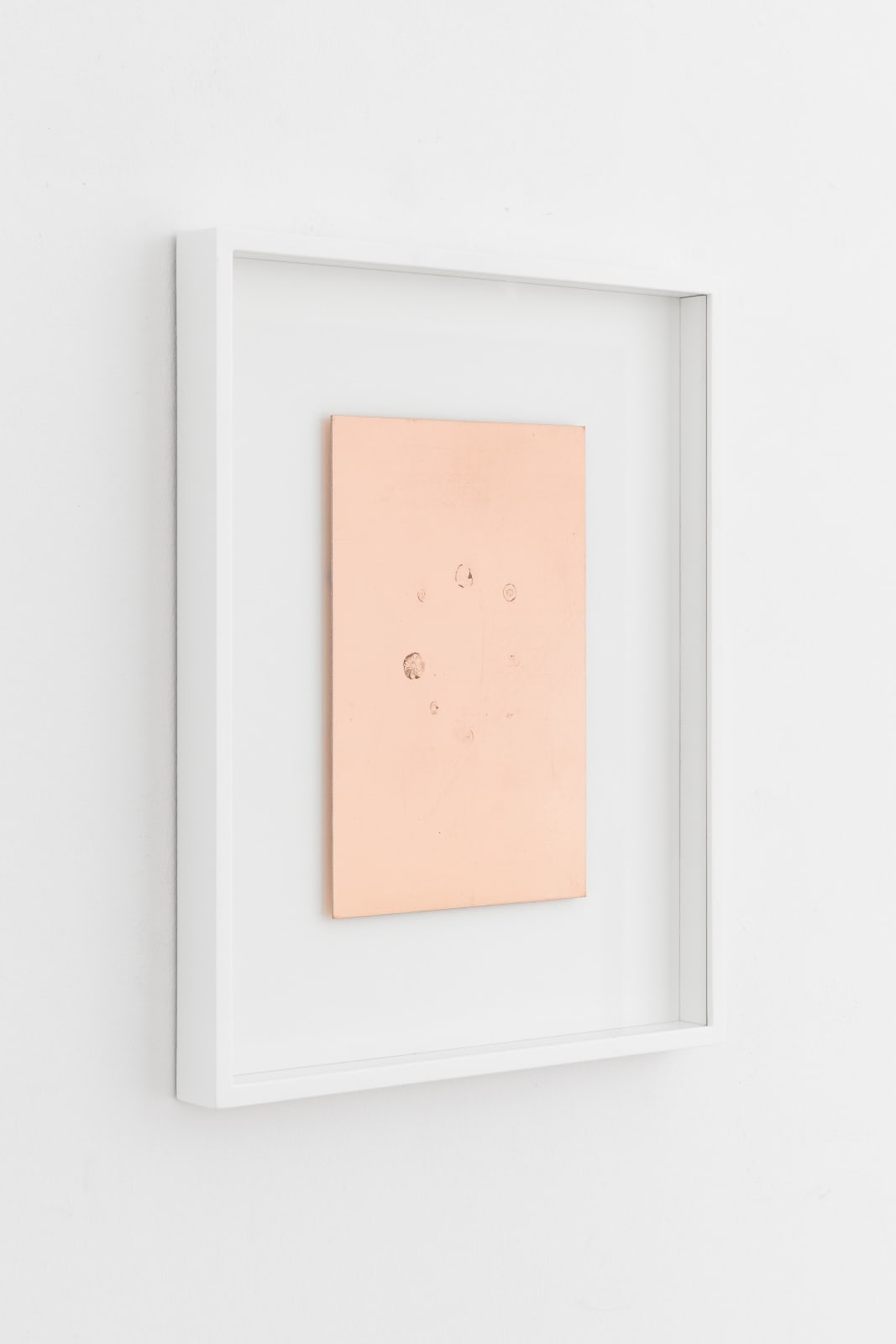Haroon Mirza
Circle of Liberty, 2017
Psylocibe semianceata spore prints electroetching on copper PCB blank
Frame:
51 x 40.5 x 4cm
201/8 x 16 x 15/8 inches
Copper PCB:
30 x 20 cm
11 3/4 x 7 7/8 inches
51 x 40.5 x 4cm
201/8 x 16 x 15/8 inches
Copper PCB:
30 x 20 cm
11 3/4 x 7 7/8 inches
Copyright The Artist
Photo: Dirk Tacke
Weitere Abbildungen
In "Circle of Liberty" (2017) legt Haroon Mirza Teile des halluzinogenen Pilzes “Psilocybe Semilanceata“, umgangsprachlich „Magic Mushroom“ oder auch „Liberty Cap“, auf eine Leiterplatte aus Kupfer und setzt diese unter Strom. Durch den Energiefluss brennen sich die Umrisse des Pilzes in die kupferne Oberfläche ein und es entsteht ein feingliedriges Abbild. Das Werk ist Teil der Serie Electro Etchings, in der der Künstler technoid-digitale und schamanistisch-magische Elemente miteinander verschmelzen lässt. Über die Entstehung dieser Werke sagt Mirza: „Ich habe mich schon immer für organische Materie, Material und Organismen interessiert, wegen ihrer chaotischen, unvorhersehbaren und autonomen Natur, und auch als Metapher für andere Dinge.“ PCB-Kupferplatten, die beispielsweise in Computern verbaut werden, in Kombination mit psychoaktiven Substanzen sind beispielhaft für Mirzas Auseinandersetzung mit traditionellen schamanistischen Ritualen und deren Transformation in unsere heutige von Technologie geprägte Zeit.
In "Circle of Liberty" (2017), Haroon Mirza places parts of the hallucinogenic mushroom "Psilocybe Semilanceata", commonly known as "Magic Mushroom" or "Liberty Cap", on a copper circuit board and conducts electrical currents through them. The flow of energy burns the outline of the mushroom onto the copper surface, creating a delicate image. The work is part of the "Electro Etchings" series, in which the artist merges technoid-digital and shamanistic-magical elements. About the creation of these works, Mirza says: "I've always been interested in organic matter, material, and organisms because of their chaotic, unpredictable and autonomous nature, and also as a metaphor for other things." PCB copper plates, which are used in computers, for example, in combination with psychoactive substances are emblematic for Mirza's exploration of traditional shamanistic rituals and their transformation into today's technology-driven world.
Created by placing organic material on copper boards and passing a current through them, Haroon Mirza’s electro-etchings fuse together the technoid-digital world and the natural, shamanistic-magical world by using organic material. "I've always been interested in organic matter, material, and organisms because of their chaotic, unpredictable and autonomous nature, and also as a metaphor for other things", the artist stated in an interview. The usage of PCB copper plates (which are normally used in computers) and drugs in shamanistic rituals is also found in other works of his internationally recognized installations, sculptures and video pieces.
The work OxyContin is related to the dramatic increase in Oxycodone abuse in the USA and refers to the prescription drug OxyContin, which contains the substance Oxycodone, an opioid which is largely credited to be the source of the opioid crises in the USA. While a sliced ginger root is placed on a electrified PCB copper plate for 6 minutes, the ginger root reacts with the plate and leaves permanent marks. Other works of the series also show a chemical reaction of the San Pedro cactus on the copper surface or other traces of organic material like garlic flowers or are connected to other drugs. For instance, Mirza made copper plates with Liberty Caps, which is the most common psychoactive mushroom.
The work OxyContin is related to the dramatic increase in Oxycodone abuse in the USA and refers to the prescription drug OxyContin, which contains the substance Oxycodone, an opioid which is largely credited to be the source of the opioid crises in the USA. While a sliced ginger root is placed on a electrified PCB copper plate for 6 minutes, the ginger root reacts with the plate and leaves permanent marks. Other works of the series also show a chemical reaction of the San Pedro cactus on the copper surface or other traces of organic material like garlic flowers or are connected to other drugs. For instance, Mirza made copper plates with Liberty Caps, which is the most common psychoactive mushroom.











